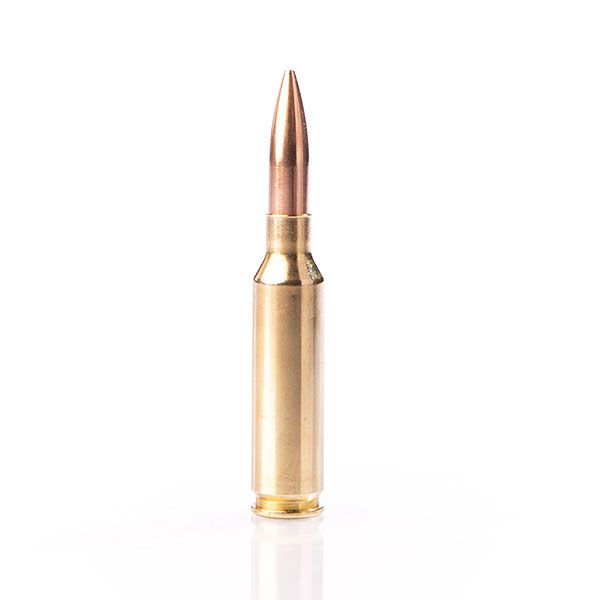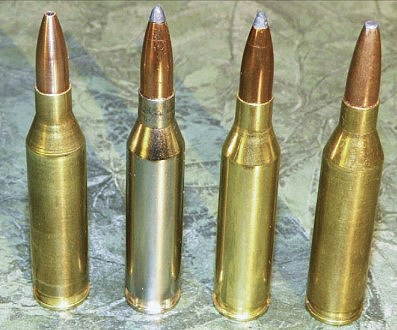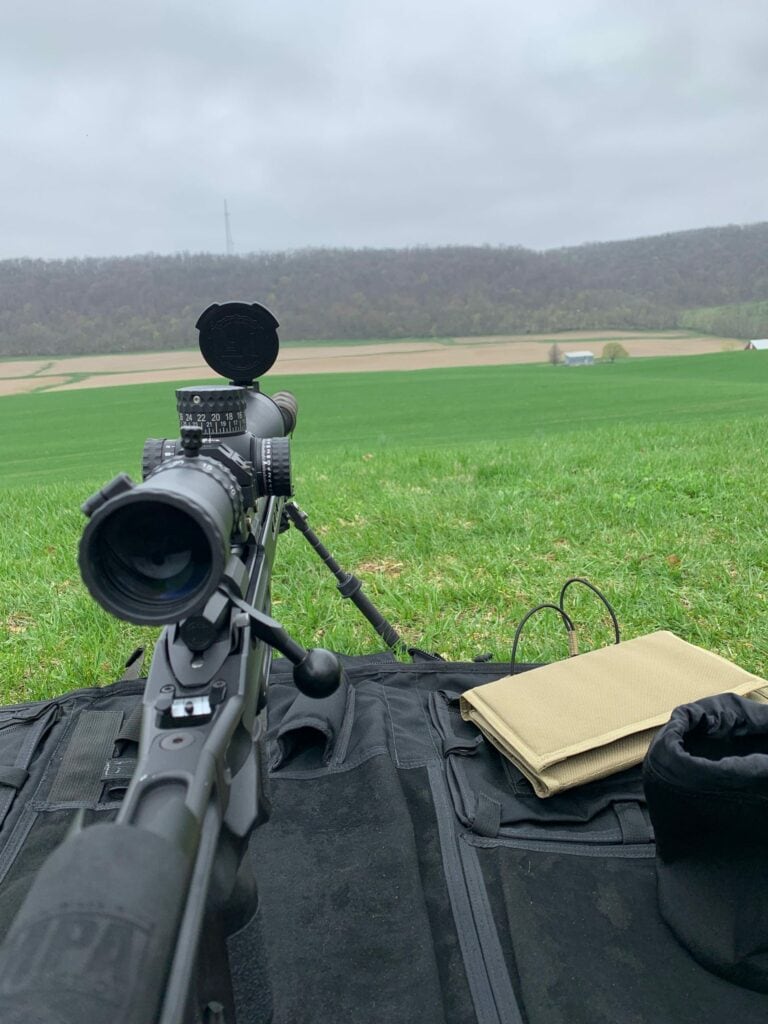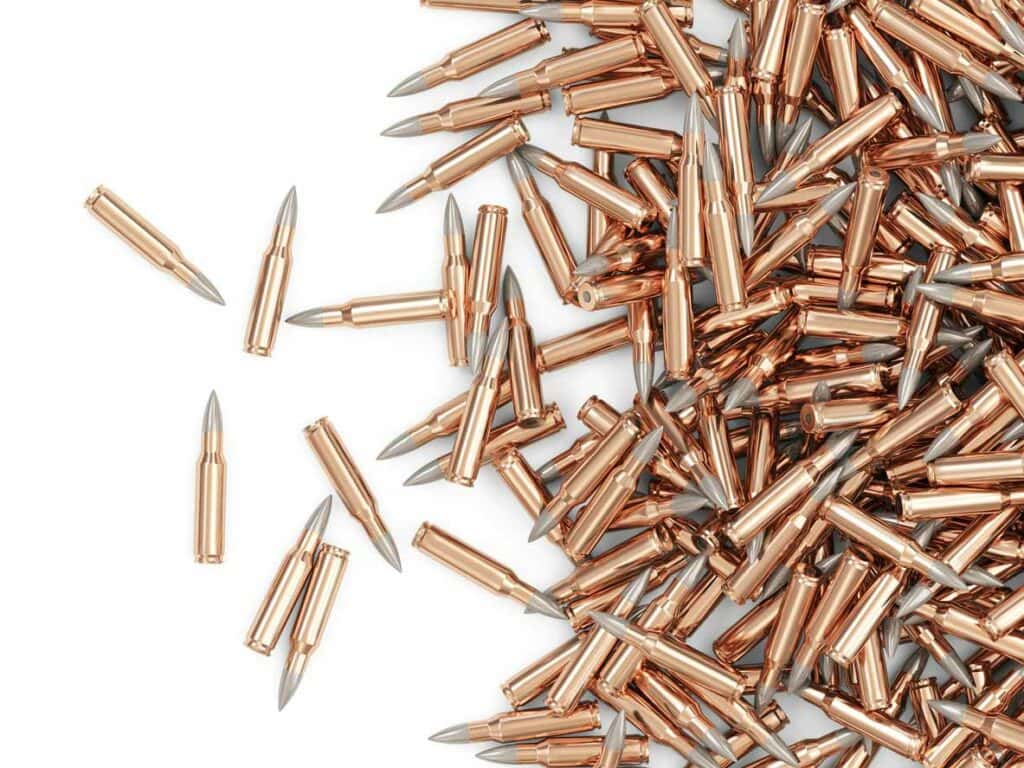The 6.5 Creedmoor is the new cool kid on the block that has earned the reputation of being a very flat shooting long range round. Its rising popularity has overshadowed many previously popular cartridges, especially after the military started using it in some capacity. But is the 6.5 Creedmoor really that excellent?
The 6.5mm caliber is not new to the firearms industry and there are several comparable calibers that people debate can outperform the 6.5 Creedmoor. We took one such venerable old-guard cartridge to make this comparison, the .243 Winchester. Looking at the data and facts, let’s find out what the hype is all about.
6.5 Creedmoor vs 243
A side-by-side comparison of the pros, cons, and best applications of these two cartridges.

6.5 Creedmoor

243

Pros
6.5 Creedmoor
Adopted by the military for sniping
Large bullets with more energy downrange
Short action design. Can be used in semi-auto rifles
Can be suitable for hunting big game animals like elk and moose
High ballistic coefficient and flat-shooting long range accuracy
243
Flatter shooting cartridge out to 500 yards
Wide range of ammo options are available
Popular and tested medium deer hunting cartridge
Suitable for short and long range applications. Plus low recoil
Cons
6.5 Creedmoor
Significant recoil
Ammo is quite expensive
Options with closely similar performance are available
243
Short barrel life
Ammo is expensive
Lightweight and thin bullets offer low penetration for big game
Best For
6.5 Creedmoor
The 6.5 Creedmoor is good for long range competitions, sniping, and taking down medium and big size games(up to Class 3).
243
The .243 Win is a tested and popular deer hunting cartridge with the capability to be used for long range shots. Shoots very flat out to 500 yards.
6.5 Creedmoor Overview
The 6.5 Creedmoor is a fairly new introduction to the world of firearms. It was developed after a partnership between Hornady and Creedmoor Sports and hit the market in 2007. The 6.5 Creedmoor is a rimless bottlenecked cartridge that fires a 0.264-inch diameter bullet. The cartridge is a necked-down version of the .30 Thompson Center cartridges.
This round was exclusively designed for long range shooting applications. It is also a slightly smaller OAL cartridge than its 6.5mm counterparts which allows it to be shot from a short action rifle as well.

The unique characteristic of these cartridges is their exceptional resistance to wind drift, or what we call a ballistic coefficient. This is what has earned it a reputation in long range competitions and many people have started to like it over the traditional options like .270 Winchester and .30 cal magnum rounds.
The 6.5 Creedmoor is also used by the United States Military in some long range rifles. It was also seen as a probable replacement for the 7.62 NATO and even 5.56 NATO rounds in the long run. However, it is a fairly new cartridge and there’s a lot that has to be tested.
243 Overview
The .243 Winchester is a rimless, bottlenecked cartridge that shoots a .243 inch diameter bullet. It was introduced in 1955 as an alternative to the .308 for game hunting and it took the market by storm. This cartridge is also colloquially called the ‘deer hunter’, which is due to its aptness and effectiveness against whitetails, pronghorns, and other medium-sized deer species. In fact, it is one of the most popular cartridges used to teach newbies the basics of deer hunting.

The .243 Winchester is also a low recoil round which makes it suitable for recoil-sensitive shooters. This cartridge uses lightweight bullets which have been designed for controlled expansion and are suitable for game hunting. Additionally, these are the smaller caliber cartridges legal for deer hunting in many states, which has added to its popularity.
The bullets of this cartridge have been optimized for long range and high velocity performance. In fact, it is one of the first cartridges to be developed after WWII for long range performance. It is a popular medium for long range competition. Due to its long history and popularity among the masses, there are a ton of bullet and handloading options available on the market.
6.5 Creedmoor vs 243: Cartridge Specs
Let’s do a quick side-by-side comparison of the dimensions of these two cartridges.
 | 6.5 Creedmoor | 243 |
|---|---|---|
| Bullet Diameter | .2644 in (6.72 mm) | .243 in (6.2 mm) |
| Neck Diameter | .2950 in (7.49 mm) | .276 in (7.0 mm) |
| Base Diameter | .4703 in (11.95 mm) | .471 in (12.0 mm) |
| Case Length | 1.920 in (48.8 mm) | 2.045 in (51.9 mm) |
| Overall Length | 2.825 in (71.8 mm) | 2.7098 in (68.83 mm) |
| Case Capacity | 52.5 grains | 53.7-54.8 grains |
| Max Pressure (SAAMI) | 62,000 psi | 60,000 psi |
| Typical Casing Material | Brass | Brass |
| Typical Bullet Weight (gr) | 120-143 grains | 60-100 grains |
The .243 Winchester and 6.5 Creedmoor cartridges are quite similar in most dimensional specs except for the bullet diameter and weight. The 6.5 Creedmoor uses a .264 inch diameter bullet and has an overall length of 2.825 inches. The .243 isn’t far behind and measures 2.7 inches in OAL and uses a thinner 0.243 inches diameter bullet.
The .243 Winchester has a marginally larger case capacity than the 6.5 Creedmoor due to its neck design, however, it is loaded at a slightly lesser maximum pressure. Both these cartridges have almost the same base rim diameter of 0.470 inches.
The 6.5 Creedmoor fires heavier bullets compared to the .243 Win. These bullets fall in the range of 120 to 143 grains and have exceptional ballistic coefficients (wind drift resistance). The .243 Win uses far lighter bullet weights ranging from 55 to 100 grains. These bullets have slightly lesser ballistic coefficients and offer good penetration and fragmentation.
These bullets are small enough to be chambered in short action-length rifles and can be fired from semi-auto rifles as well.

6.5 Creedmoor vs 243: Ballistics
The ballistics of a bullet describes its capability to maintain a stable flight path and deliver expected results over a specific distance. The ballistics section will cover the trajectory, velocity, and energy characteristics of bullets fired from both these cartridges.
The ballistics data will help determine if a bullet is suitable for short or long range engagements due to its drop characteristics. Additionally, it also describes what sized targets (game animals) can a bullet handle pertaining to its energy values at a certain range. Plus, the velocity also gives us some insights into the accuracy of the bullet over a certain range. Since both these bullets are suitable for long distances, the ballistics data will be quite interesting to see.
6.5 Creedmoor vs 243: Trajectory
While the 6.5 Creedmoor was exclusively designed for long range engagements, the .243 Win is also suitable for such distances. Let’s look at their drop value over a long range. Both the rifles were zeroed for a distance of yards.
6.5 Creedmoor
| 24” barrel/BC 0.497/120 gr Trophy Copper | 24” barrel/BC 0.365/130 gr Barnes Triple Shock-X | 24” barrel/BC 0.509/140 gr Nosler Accubond |
|---|---|---|
| 150 yds: 1“ Drop | 150 yds: 1.1“ Drop | 150 yds: 1.3“ Drop |
| 200 yds: 3.3“ Drop | 200 yds: 3.7“ Drop | 200 yds: 4.1“ Drop |
| 300 yds: 12.1“ Drop | 300 yds: 13.9“ Drop | 300 yds: 14.6“ Drop |
| 400 yds: 27.4“ Drop | 400 yds: 31.6“ Drop | 400 yds: 32.4“ Drop |
| 500 yds: 49.9“ Drop | 500 yds: 59.3“ Drop | 500 yds: 58.5“ Drop |
| 1,000 yds: 327“ Drop | 1,000 yds: 451.6“ Drop | 1,000 yds: 381“ Drop |
.243 Winchester
| 24”barrel/BC 0.234/75 gr JHP | 24” barrel/BC 0.376/90 gr Nosler Accubond | 24”barrel/BC 0.384/100 gr Nosler Partition |
|---|---|---|
| 150 yds: 0.7“ Drop | 150 yds: 0.8“ Drop | 150 yds: 1.1“ Drop |
| 200 yds: 2.5“ Drop | 200 yds: 2.8“ Drop | 200 yds: 3.6“ Drop |
| 300 yds: 10.5“ Drop | 300 yds: 10.8“ Drop | 300 yds: 13.4“ Drop |
| 400 yds: 25.6“ Drop | 400 yds: 25“ Drop | 400 yds: 30.4“ Drop |
| 500 yds: 51.4“ Drop | 500 yds: 46.6“ Drop | 500 yds: 56.5“ Drop |
| 1,000 yds: 522.1“ Drop | 1,000 yds: 350.8“ Drop | 1,000 yds: 419.9“ Drop |
Comparing the trajectories of these two bullets is somewhat of a mixed tale. The .243 Win was around for a long long time before the 6.5 Creedmoor was introduced. Looking closely at the data, it is clearly evident that with bullets of comparable weight class (light, medium, or heavy), the .243 Winchester exhibits amazing drop performance within a range of 500 yards.
The heaviest .243 Winchester bullets (100 grain) drop less than the heaviest 6.5 Creedmoor bullets (143 grain) within 500 yards. However, as the range increases, the .243 Win bullets quickly lose altitude due to their light weight.
The only exception to the drop characteristics is the 90 grain Nosler Accubond .243 Win bullet which shows an amazing drop value of just 350.8 inches at 1,000 yards compared to 6.5 Creedmoor 130 grain Barnes Triple Shock-X bullets which show a drop of 451 inches.
So is the 6.5 Creedmoor really an innovative modern cartridge with an edge over the .243 Win? I’d say yes because the factors where it excels are wind resistance (ballistic coefficient) and long range trajectory (beyond 500 yards).
If you are looking for a 1,000 yard round that needs little adjustment and can shoot well on a windy day, the 6.5 Creedmoor will be a better choice in the long run for competitive shooters.

6.5 Creedmoor vs 243: Velocity & Kinetic Energy
The velocity and kinetic energy characteristics are helpful in determining how much speed and power a bullet carries at different ranges. These values help analyze if a bullet is suitable for a specific game at a certain range (both technically and legally) and the accuracy characteristics as well.
6.5 Creedmoor
| 24” barrel/BC 0.497/120 gr Trophy Copper | 24” barrel/BC 0.365/130 gr Barnes Triple Shock-X | 24” barrel/BC 0.509/140 gr Nosler Accubond |
|---|---|---|
| 150 yds: 2,599 ft/s, 1,799 ft.lbs | 150 yds: 2,457 ft/s, 1,742 ft.lbs | 150 yds: 2,416 ft/s, 1,815 ft.lbs |
| 200 yds: 2,510 ft/s, 1,679 ft.lbs | 200 yds: 2,341 ft/s, 1,581 ft.lbs | 200 yds: 2,334 ft/s, 1,693 ft.lbs |
| 300 yds: 2,338 ft/s, 1,457 ft.lbs | 300 yds: 2,118 ft/s, 1,294 ft.lbs | 300 yds: 2,173 ft/s, 1,467 ft.lbs |
| 400 yds: 2,174 ft/s, 1,259 ft.lbs | 400 yds: 1,906 ft/s, 1,049 ft.lbs | 400 yds: 2,018 ft/s, 1,266 ft.lbs |
| 500 yds: 2,015 ft/s, 1,082 ft.lbs | 500 yds: 1,711 ft/s, 845 ft.lbs | 500 yds: 1,870 ft/s, 1,086 ft.lbs |
| 1,000 yds: 1,349 ft/s, 485 ft.lbs | 1,000 yds: 1,047 ft/s, 316 ft.lbs | 1,000 yds: 1,264 ft/s, 496 ft.lbs |
.243 Winchester
| 24”barrel/BC 0.234/75 gr JHP | 24” barrel/BC 0.376/90 gr Nosler Accubond | 24”barrel/BC 0.384/100 gr Nosler Partition |
|---|---|---|
| 150 yds: 2,743 ft/s, 1,253 ft.lbs | 150 yds: 2,720 ft/s, 1,478 ft.lbs | 150 yds: 2,498 ft/s, 1,385 ft.lbs |
| 200 yds: 2,551 ft/s, 1,084 ft.lbs | 200 yds: 2,600 ft/s, 1,351 ft.lbs | 200 yds: 2,386 ft/s, 1,264 ft.lbs |
| 300 yds: 2,191 ft/s, 800 ft.lbs | 300 yds: 2,370 ft/s, 1,122 ft.lbs | 300 yds: 2,171 ft/s, 1,047 ft.lbs |
| 400 yds: 1,861 ft/s, 577 ft.lbs | 400 yds: 2,152 ft/s, 925 ft.lbs | 400 yds: 1,968 ft/s, 860 ft.lbs |
| 500 yds: 1,579 ft/s, 410 ft.lbs | 500 yds: 1,945 ft/s, 756 ft.lbs | 500 yds: 1,776 ft/s, 701 ft.lbs |
| 1,000 yds: 876 ft/s, 123 ft.lbs | 1,000 yds: 1159 ft/s, 268 ft.lbs | 1,000 yds: 1,091 ft/s, 264 ft.lbs |
The 6.5 Creedmoor has an average muzzle velocity of 2,700 fps compared to the 3,150 fps average muzzle velocity of .243 Winchester. The lightweight .243 Win bullet travels faster initially and the best performance can be found out with 90 grains Nosler Accubond bullets which stay supersonic beyond 1,000 yards.
As far as long range velocity performance is concerned, the 6.5 Creedmoor certainly has an edge and the bullets stay supersonic beyond 1,000 yards making the performance more predictable. The .243 Win is a faster round up to a distance of 300 yards after which the 6.5 Creedmoor starts overpowering the velocity.
This difference in velocity is what makes the .243 Win shoot a bit flatter inside a range of 500 yards compared to the 6.5 Creedmoor.
Talking about the energy, the heavier 6.5 Creedmoor bullets will always carry more energy than the comparably lightweight .243 Win bullets. In fact, the 6.5 Creedmoor retains almost twice as much energy at 1,000 yards as the .243 Win.
However, the 1,000 fpe of energy retention within a range of 300 yards is what makes the .243 Win a preferable deer cartridge. Additionally, the .243 Win has almost half as recoil energy as compared to the 6.5 Creedmoor, making it suitable for recoil sensitive or smaller shooters.

6.5 Creedmoor vs 243: Stopping Power
The stopping power of a bullet describes its ability to incapacitate or kill a target within the least number of rounds and as quickly as possible. Bigger cartridges have more power and hit harder compared to smaller cartridges. However, the exact method to measure the stopping power is to measure the sectional density, momentum, and penetration of a bullet. The former two metrics are useful in measuring the third one.
The stopping power gives an idea of how better the bullet will penetrate into different targets (apart from fragmentation characteristics which are dependent upon the bullet type) and what game/armor it is suitable for.
6.5 Creedmoor vs 243: Momentum & Sectional Density
The sectional density of a bullet is the ratio of its mass to its cross-sectional area. The higher the value of sectional density, the more penetration a bullet has when traveling at an optimum velocity. Which is further measured by the momentum of the bullet. Let us understand these in more detail.
6.5 Creedmoor
| 24” barrel/BC 0.497/120 gr Trophy Copper Sectional Density: 0.246 | 24” barrel/BC 0.365/130 gr Barnes Triple Shock-X Sectional Density: 0.266 | 24” barrel/BC 0.509/140 gr Nosler Accubond Sectional Density: 0.287 |
|---|---|---|
| 150 yds: 44 ft.lb-s | 150 yds: 45 ft.lb-s | 150 yds: 48 ft.lb-s |
| 200 yds: 43 ft.lb-s | 200 yds: 43 ft.lb-s | 200 yds: 46 ft.lb-s |
| 300 yds: 40 ft.lb-s | 300 yds: 39 ft.lb-s | 300 yds: 43 ft.lb-s |
| 400 yds: ft.37 lb-s | 400 yds: 35 ft.lb-s | 400 yds: 40 ft.lb-s |
| 500 yds: ft.34 lb-s | 500 yds: 31 ft.lb-s | 500 yds: 37 ft.lb-s |
| 1,000 yds: ft.23 lb-s | 1,000 yds: 19 ft.lb-s | 1,000 yds: 25 ft.lb-s |
.243 Winchester
| 24”barrel/BC 0.234/75 gr JHP Sectional Density: 0.181 | 24” barrel/BC 0.376/90 gr Nosler Accubond Sectional Density: 0.218 | 24”barrel/BC 0.384/100 gr Nosler Partition Sectional Density: 0.242 |
|---|---|---|
| 150 yds: 29 ft.lb-s | 150 yds: 34 ft.lb-s | 150 yds: 35 ft.lb-s |
| 200 yds: 27 ft.lb-s | 200 yds: 33 ft.lb-s | 200 yds: 34 ft.lb-s |
| 300 yds: 23 ft.lb-s | 300 yds: 30 ft.lb-s | 300 yds: 31 ft.lb-s |
| 400 yds: 19 ft.lb-s | 400 yds: 27 ft.lb-s | 400 yds: 28 ft.lb-s |
| 500 yds: 17 ft.lb-s | 500 yds: 25 ft.lb-s | 500 yds: 25 ft.lb-s |
| 1,000 yds: 9 ft.lb-s | 1,000 yds: 14 ft.lb-s | 1,000 yds: 15 ft.lb-s |
According to the general rule of thumb, bullets with sectional density (SD) less than 0.200 are suitable for small game and varmints. Bullets with SD in the range of 0.200 to 0.260 are good for Class 2 medium-sized game like deer and pronghorns. However, that SD is also subjective to bullet weight and momentum.
Bullets with SD greater than 0.260 are suitable for Class 3 big sized game like elk and deer. So looking at our data, it is clearly evident that the 6.5 Creedmoor will always have enough energy to kill a deer with its lightweight bullets, and it can also handle Class 3 games like elk and moose with the heavier bullets.
The 6.5 Creedmoor uses a larger diameter bullet which means it will create a bigger hole compared to the .243 Win. Additionally, it also carries more kinetic energy and velocity downrange so with the right bullets it will cause better penetration, fragmentation, and tissue damage.
Coming on to the next factor which is momentum, let’s first understand what it does. The momentum of the bullet describes the effectiveness of energy transfer from the bullet to the target. The higher the value, the more stopping power and hence the damage.
According to the general rule of thumb, a momentum of in the range of 35-40 ft. lb-s is considered optimal to kill a deer. The 6.5 Creedmoor carries ample momentum to do that out to a range of 400 yards. Whereas the .243 can do that effectively out to a range of 300 yards with its heavy bullets (90 and 100 grains).
6.5 Creedmoor vs 243: Use Cases & Effective Range
After analyzing all that data and metrics, it is now time to understand the applications for which each of these bullets is good for.
Accurate Long Range Shooting
The long range performance of both these cartridges boils down to the numbers. While the 6.5 Creedmoor was developed to be an accurate long range cartridge, the .243 is more of a hunting round. The 6.5 Creedmoor bullets clearly depict a better long range performance, however, there are a few specific loads in the .243 Win (like the 90 grain Nosler Accubond bullet) that can outperform them at long range.
For businesses within the range of 500 yards, the .243 Win bullets outmatch the 6.5 Creedmoor with their heavy grain variants (90/100 grains). However, when the range exceeds that mark, the 6.5 Creedmoor will certainly have an advantage in about 95% of cases.
If you are explicitly going for an F-class competition, the 6.5 Creedmoor will be a better choice. Additionally, if you want a general purpose long range rifle not being so sure about the range, the 6.5 Creedmoor will still be a better choice.

Medium or Big Game Hunting
The .243 has a stout reputation as a hunting cartridge for many years now. It has been seen as the best whitetail cartridge of all time and there is certainly no doubt about that. It is a great round for medium sized game like deer within a range of 300 yards, but that too with heavy bullets like the 90 and 100 grains. It is unfortunately not a good choice for big game like elk and moose. So big game hunting is clearly a no-go.
The 6.5 Creedmoor fires a larger bullet and has a higher sectional density along with more kinetic energy downrange. With a minimum energy requirement of 1,500 fpe for moose and elk, most 6.5 Creedmoor bullets can take them down out to a range of 300 yards.
Tactical Uses
The 6.5 Creedmoor fits the tactical role really well and is already being used by the United States Military in some capacity. Being a short action round, it can be shot from semi-auto rifles and has the long range potential for the combat sniper role.
However, if you are a prepper the .243 Win with its low recoil lightweight ammo and optimal long range will be more suitable.
6.5 Creedmoor vs 243: Costs, Availability, & Compatibility
Check out the costs, availability, and available rifle and aftermarket options for these cartridges.
Available But Far from Cheap
The .243 Winchester has long been used for hunting and is an extremely popular sporting round. So there is a slim chance that the market will ever run out of ammo. The same is the case with 6.5 Creedmoor as it has slowly started to gain traction and has become quite popular among the masses.
Both these cartridges are rather very feasible options to choose from because they are not very prone to disappearing during panic buying, like the one we saw during the Covid-19 pandemic. However, it is always great to have some extra backup ammo and handloading supplies.

Talking about the price, the cost per round for both these rounds ranges from $1.50 to $4 per cartridge. So clearly, neither of these rounds is dirt cheap and will put a significant burden on your wallet if you spend a lot of ammo.
The price has definitely surged recently due to the panic buying shortages and will probably break down a bit in the future. However, the cost is a good reason to buy handloading supplies and sharpen your accuracy skills. Neither of these is the mag-dump kind of round but can be easily found on the market.
Bolt Action vs Semi-Auto
While both of these are standard action cartridges, the .243 Winchester never really gained popularity for semi-auto rifle versions and is mostly found with bolt-action rifles. On the other hand, the 6.5 Creedmoor is available in both rifle options and its integration with the popular AR-15 platform opened a ton of possibilities for aftermarket accessories and upgrades.
Bottom Line
The .243 Winchester is an extremely popular sporting round for the past seven decades and is widely used for hunting deer. The 6.5 Creedmoor is a fairly recent development of the 6.5mm caliber ammo and can be seen as a shortened version of the .308 Win cartridge with better long range accuracy.
Bullets from both these cartridges shoot exceptionally flat out to a range of 500 yards, after with the 6.5 Creedmoor begins to have a slight edge. The 6.5 Creedmoor is a more powerful round with a bigger bullet and more energy down range. Additionally, it is also available in semi-auto and bolt action rifle options with a lot of aftermarket upgrade options.
The .243 Win is a great round for recoil sensitive hunters and is also great to teach newbies the basics of deer hunting. While specific bullet types/loads may outmatch one another, the 6.5 Creedmoor certainly has an edge over the .243 Win.
People Also Ask
Introduce yourself to the answers for some common queries and misconceptions about the 6.5 Creedmoor and .243 Winchester cartridges.
The 6.5 Creedmoor is comparable to .260 Remington and 6.5-284 Norma, taking into consideration the muzzle velocity, energy, ballistic coefficient, recoil, and size characteristics. While the 6.5mm caliber is almost a century old with many bullet options, the 6.5 Creedmoor was introduced in 2008 and has taken the market by storm.
Yes. The USSOCOM and some units of the United States Military have already switched out to the 6.5 Creedmoor in a limited capacity and this round is being used exclusively for sniper rifles. The flat-shooting trajectory, high velocity, and good energy retention out to a long range make it an effective sniping round.
.243 Winchester bullets show impressive trajectory characteristics out to 500 yards with an average drop of 50 inches. Heavier bullets stay supersonic past 1,000 yards and can show a drop as low as 350 inches. So it is safe to say that a .243 Win can accurately and easily take 1,000-yard shots with the right ammo and in the right hands.
No, the .243 Win is not more powerful than a 6.5 Creedmoor due to its lower bullet mass, lesser bullet diameter, and smaller sectional density value. However, it is a fairly powerful round to take down deer out to a range of about 350 yards.


